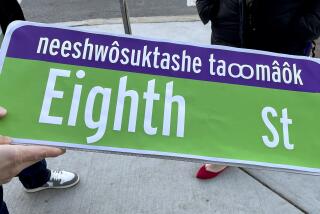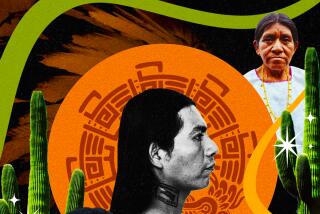Ancient Mayan Symbols Yield New Meaning
- Share via
For years, archeologists pored over the stone-hewed jaguars and shamans of Mayan hieroglyphics, viewing them as keys to unlocking the mysteries of a civilization that flourished as the Roman Empire was crumbling and now lies buried beneath a thick jungle canopy.
Today, many scholars have turned to modern Mayan languages to help decode the hieroglyphs--desperate to shed light on the rise and fall of the Maya, who constructed elaborate pyramids from about AD 300 to 800 in a vast area from Mexico to Guatemala, Belize and Honduras.
The academicians described this struggle Saturday at an annual UCLA conference that showcases research on the ancient Maya civilization.
Thirty-nine languages of the Mayan family are still used daily by millions of Indians. Most of the languages are as different from each other as English and Dutch. Two of the most common highland tongues, Kanjobal and Quiche Maya, are used by Maya immigrants in California.
The discovery of the link between the hieroglyphics and modern Mayan languages is fairly recent, and its use has grown swiftly, scholars said.
“It has really picked up in the last decade,” said Simon Martin, a research fellow at University College of London, who presented a paper called “Kings and Overkings: Political Dynamics Within the Classical Maya Civilization.”
“It’s about ever more sophisticated reading,” he said. “The goal is to be able to read things exactly as they were spoken 1,000 years ago, rather than just an approximation.”
A library of Mayan texts that could have given modern archeologists tremendous insights into the codices was burned in the 1500s by the Spanish bishop of the Yucatan, Diego de Landa, who believed them to be heresy. Only four, sent by someone to Europe, survived.
Ironically, the bishop also created something that helped future scholars tremendously--a sort of dictionary of how the hieroglyphics worked. He translated the pictures of animals and symbols into alphabetic letters, Martin said.
Unfortunately, De Landa misunderstood much of it. He produced a list of signs he thought corresponded to letters of the Spanish alphabet. A few he gave two letters to, suggesting they might be syllabic.
But it was not until the 1950s that scholar Yuri Knorosov discovered that the pictures did not represent single letters, but syllables, Martin said.
“The phonetic breakthrough was not just important, it was absolutely fundamental,” Martin said.
Working in the Soviet Union in the 1950s, Knorosov was able to cross-reference De Landa’s alphabet with signs he could identify from surviving Mayan texts. Once he identified those, he could associate them with animals pictured in the Mayan books. Knorosov turned to the modern Yucatec language to help piece together their meanings, because it is the closest language to what many ancient Mayas of the region were speaking during the Classical Era, between AD 200 and 900.
“You develop a hypothesis, then piece together other fragments to prove your hypothesis,” Martin said. “What’s picked up recently are knowing the languages most closely related to the script. All languages are relevant; it’s a question of just how relevant. We’re now focusing on modern Chorti.”
Yucatecan and Cholan were the two main language groups used by the Mayas who inhabited lowland Classical-era cities like Tikal, Caracol and Copan, Martin said. Cholan was spoken by the elite, he said.
Scholars are also looking at Acalan Chontal, spoken in southern Mexico, he said.
Yucatecan survives through modern Yucatec. One Cholan counterpart, Cholti, is now extinct, but scholars are examining modern Cholan languages like Chorti, which is used along the border of Guatemala and Honduras, near the Copan ruins, said Karl Taube, an associate professor of anthropology at UC Riverside.
“Knowing Yucatec has greatly helped my research,” said Taube, who presented a paper at the conference called “Dying Gods and Rising Suns,” on the iconography of a temple at the Maya ruin of Copan in Honduras.
Scholars are also looking at Acalan Chontal, he said.
Some view it as an incredible feat of cultural endurance that Mayan languages have endured in the face of hundreds of years of discrimination that continues to this day.
In the 1980s, the Guatemalan army’s scorched-earth campaigns massacred villagers believed to be leftist guerrilla sympathizers, prompting many Guatemalans to flee to Mexico and the United States.
More to Read
Sign up for Essential California
The most important California stories and recommendations in your inbox every morning.
You may occasionally receive promotional content from the Los Angeles Times.













